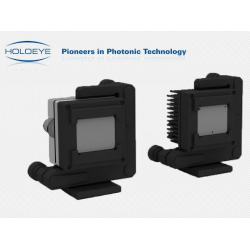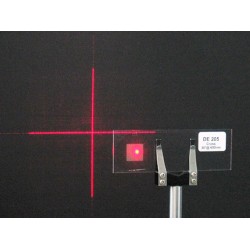GAEA-2
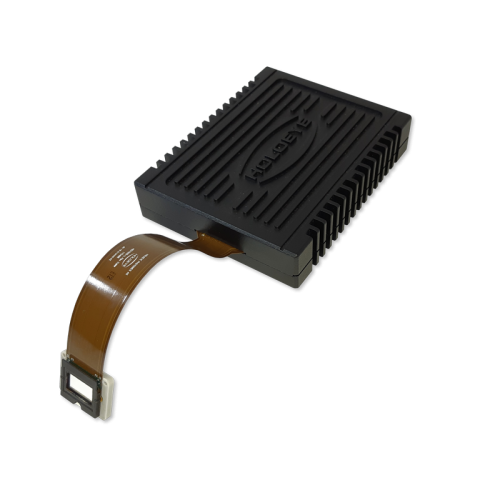
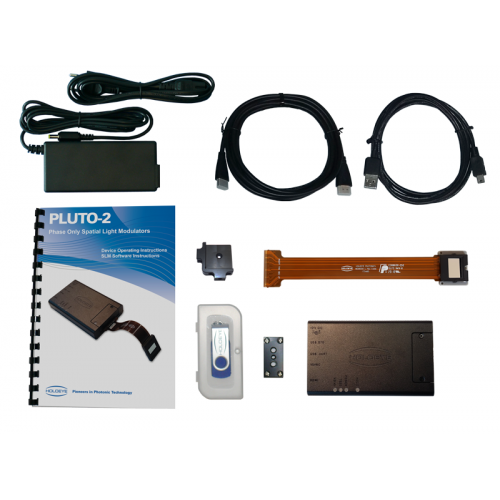
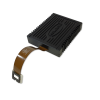

GAEA-2 Ultra HDTV 10MP phase only SLM
GAEA-2

- Ultra HDTV 4k resolution (4160 x 2464 max)
- Pixel pitch: 3.74 µm
- Fill factor: 90%
- Active area: 15.56 x 9.22 mm
- Signal type: HDMI-2
- 60 Hz image frame rate
- Phase only modulation
- Reflective LCOS microdisplay
- 2π or more phase modulation
The GAEA-2 phase only Spatial Light Modulator (SLM) consists of a driver unit with standard digital video interface (HDMI) and a phase only LCOS (Liquid Crystal on Silicon) microdisplay with a 10 megapixel (4K) resolution of 4094 x 2464 pixels, and 3.74 µm pixel pitch leading to an active area of 0.7" as measured diagonally. The very small pixel size of the GAEA-2 SLM display ensures high diffraction angles.
The GAEA-2 SLM is a plug & play device and can be addressed with phase functions via standard graphics cards as an extended monitor. It offers 8-bit grey level patterns (= 8-bit phase levels) providing the graphics card is able to deliver an uncompressed output at 3840 x 2160 pixel resolution. Addressing can easily be done using the supplied Application Software or other standard image viewer software.
The very small pixel size of the GAEA-2 SLM display enables high diffraction angles of up to 12°.
HOLOEYE offers three versions of GAEA-2 optimised for the use in different wavelength ranges: VIS for 420 to 650 nm, NIR for 650 to 1100 nm, and TELCO for 1400 to 1700 nm.
Model overview

| Version | Wavelength (nm) |
Refl. | Phase Shift (Max.) |
| GAEA-2-VIS-036 | 420–650 | 90 % | 4.8π @ 452 nm 3.6π @ 532 nm 2.8π @ 650 nm |
| GAEA-2-NIR-069 | 650–1100 | 90 % | 2π @ 1064 nm |
| GAEA-2-TELCO-033 | 1400–1700 | 90 % | 2.2π @ 1550 nm |
Please contact us for the latest price.
A number of papers have been published by scientists around the globe who have used a HOLOEYE GAEA series SLM in their research. Here are some examples:
- LCoS SLM Study and Its Application in Wavelength Selective Switch
- Single SLM full-color holographic 3-D display based on sampling and selective frequency-filtering methods
- Holographic image generation with a thin-film resonance caused by chalcogenide phase-change material
- Micro-displays for Holography
A database of published papers, searchable by device or application, can be also found on the HOLOEYE website here.
GAEA-2 SLM Product Introduction
Configuring a GAEA-2 SLM
Elementary Optical Functions
The HOLOEYE Spatial Light Modulator Pattern Generator software was developed for use with all HOLOEYE SLM models. The software allows the simple generation of diverse dynamic optical functions like gratings, lenses, axicons and apertures as well as the calculation of diffractive optical elements (DOE) from user defined images.
Besides the generation of DOEs a wide range of basic optical functions can be created directly via the menu bar. After input of the required parameters the output image appears in a new window. There are several binary and multilevel optical functions possible:
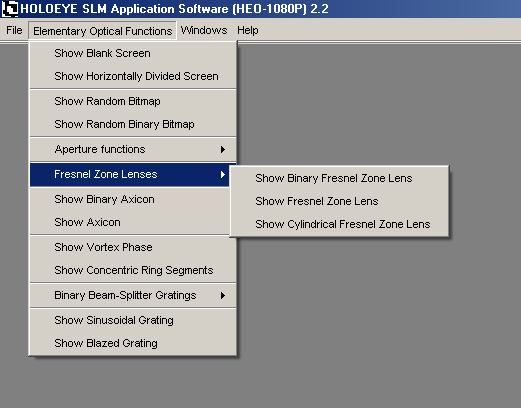
- Blank Grey Level Screen
With this function you can create a homogeneous gray level screen.
- Horizontally Divided Screen
With this function you will create a horizontally divided screen, consisting of two homogeneous graylevel partial screens.
- Random Bitmap
With this function you will create a random pixel distribution using 256 grayscale values. This function can be used to realize the optical function of a random phase plate.
- Aperture Functions
- Rectangular Aperture
- Circular Aperture
-Single Slit and Double Slit
- Fresnel Zone Lenses
-Binary Fresnel Zone Lens
-Multilevel Fresnel Zone Lens
-Cylindrical Fresnel Zone Lens
- Binary Axicon
With this function you will create a Binary Axicon graylevel image representation.
- Axicon
With this function you will create a 256-level Axicon graylevel image representation.
- Vortex Phase
Use this function to create a 256-graylevel image representation of a vortex phase.
- Concentric ring segments
Use this function to create binary images consisting of concentric ring segments.
- Binary beam-splitter gratings
-Linear Gratings and Crossed Linear gratings
-Exemplary binary beam-splitter designs
- Sinusoidal Grating
With this function you will create a sinusoidal grating.
- Blazed Grating
With this function you will create a blazed grating.
- Calculating a beam-shaping phase function for Gaussian Input beams
-Transformation of a Gaussian beam to a circular ‘flat-top’ beam
-Transformation of a Gaussian beam to a rectangular ‘flat-top’ beam
- Superposition with an additional phase map
- e.g. for compensation of aberrations of the optical system or of the SLM




